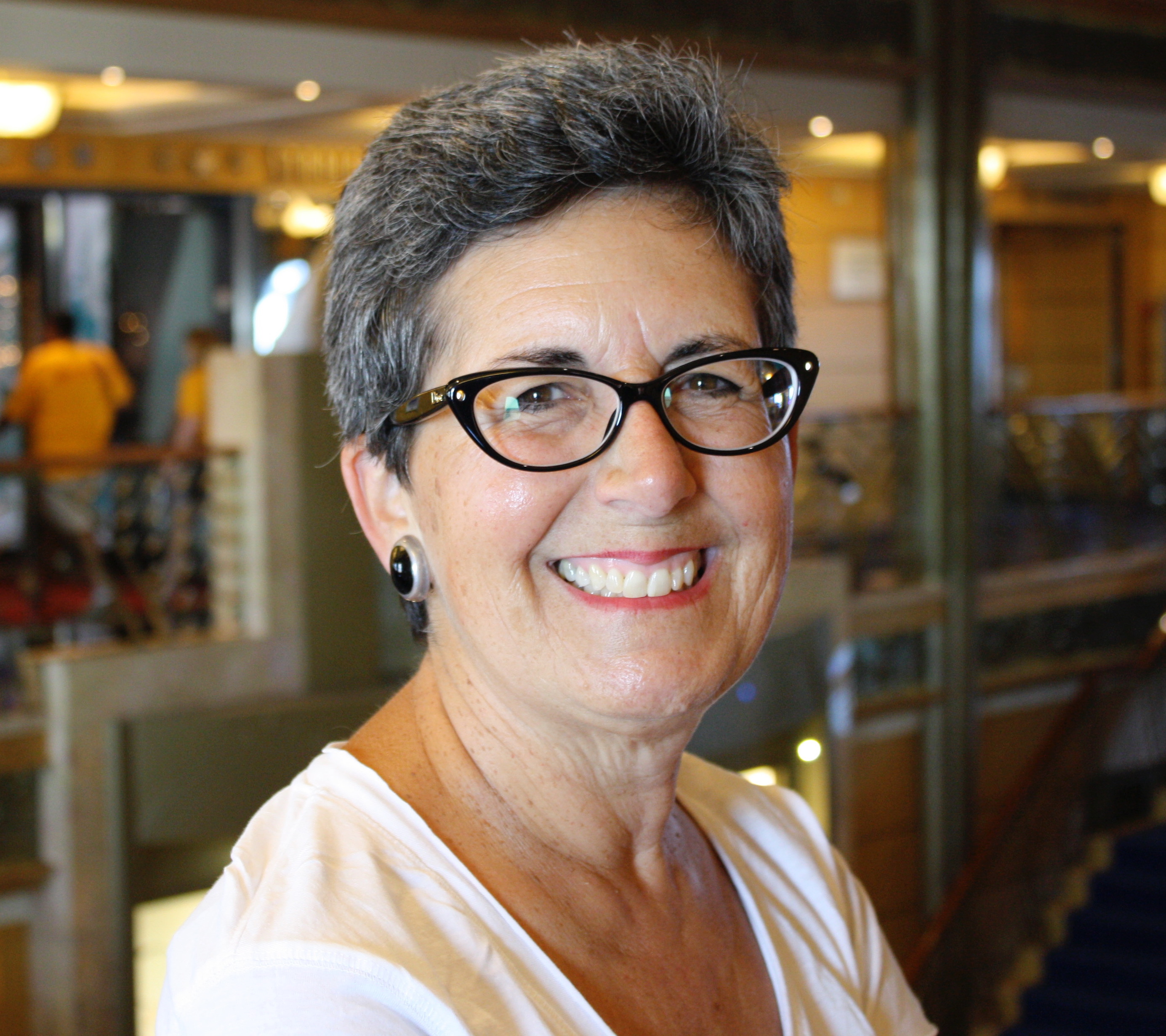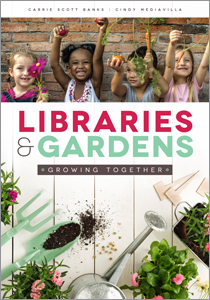Why libraries and gardens are a natural fit: an interview with Carrie Scott Banks and Cindy Mediavilla
Like libraries, gardens are nuturing environments for both individuals and communities; and today, libraries nationwide are beginning to incorporate gardens into their public services. Banks's and Mediavilla's new book is, in fact, the first-ever book on this trend and showcases several beautiful library gardens from around the world. And as they make clear in this interview, you don't need a green thumb to begin cultivating one!
Both of you have written books for ALA Editions before, but this one feels like something of a departure from your earlier titles. What was the genesis of the project and how did it finally all come together?
Carrie Scott Banks: I had been thinking about submitting a proposal for a book based on the garden manual we developed here at Brooklyn Public Library’s Inclusive Services. Our gardening program is rooted in Universal Design for Learning and the goal was to create a program that was truly  inclusive, working equally well for children with and without disabilities. So, as I was thinking about a new book on gardening, [ALA Editions acquisitions editor] Jamie Santoro emailed and asked if I was interested in a new book project about libraries and gardens! Pairing Cindy and I was genius on her part. Our skills and interests complemented each other’s well. Cindy is an actual gardener with a background in management and I like designing programs and developing partnerships.
inclusive, working equally well for children with and without disabilities. So, as I was thinking about a new book on gardening, [ALA Editions acquisitions editor] Jamie Santoro emailed and asked if I was interested in a new book project about libraries and gardens! Pairing Cindy and I was genius on her part. Our skills and interests complemented each other’s well. Cindy is an actual gardener with a background in management and I like designing programs and developing partnerships.
Cindy Mediavilla: As we relate in the book, I was working for the California State Library when governor Jerry Brown announced statewide watering restrictions due to the years-long drought. My husband and I had converted our lawns into drought-tolerant, native plant gardens several years before, so I was pleased when the California state librarian began awarding federal grants supporting native garden demonstration projects at public libraries. Following up on these projects, I discovered the many community needs these library gardens served. Some garden-based programs showed local residents how to sustain beautiful native landscapes even during severe water-restrictive periods, while others served as a healthy food source in low-income neighborhoods. I immediately saw the potential for a book to help advise libraries on how to extend their services through gardens. However, since I was focusing primarily on the West coast, ALA acquisitions editor Jamie Santoro connected me with co-author Carrie Banks, from Brooklyn Public Library, to help broaden the book’s scope. Together we laid-out a table of contents of everything the book should address and then divided up the workload according to our areas of interest and expertise. Although we did visit some libraries, most of our research was done via the Internet, email and telephone interviews. Carrie, in particular, was adamant that we include all types of libraries representing every continent and even found photos of a library on Antarctica that has an indoor palm tree and a collection of potted plants!
What was one of the most unexpected or creative gardens you came across while writing the book?
CSB: The most surprising to me was the aquaponic garden at the Marcia R. Garza elementary school library in Texas. The small garden/aquarium in a fish tank sits on the checkout desk in the library of this bilingual school and was initially financed through a DonorsChoose.org request, which was how I discovered it. After they saw it, every teacher wanted one and that first garden spread into all of the classroom. At one point, they put it on a truck took it out into the community to show people what they were doing. Parents and students stop by before school to see how it is doing. All this in a small school with limited resources that crowd sourced the $100 initial funding.
CM: All of the libraries we wrote about are, of course, wonderful, but one of the biggest surprises for me was what is called “outdoor reading areas.” These often serve to extend the library’s program space out of doors, where community members can read, play or just contemplate nature. Another  version are rooftop reading gardens—a phenomenon, relatively common in early 20th-century public libraries, that has reemerged as an extremely popular feature of new library buildings in Austin, Texas, Salt Lake City, and Vancouver. My absolute favorite library garden, however, can be found in the Reno branch of Washoe County Library in Nevada. When plans to build the library next to the Truckee River fell through in the mid-1960s, the architect reportedly said, “If we can’t put the library in the park, we’ll put a park in the library.” He then proceeded to design the library around an indoor atrium that is home today to some thirteen hundred plants. As one historian proclaimed, “It is difficult to know whether to classify this building as a library or as a botanical garden.” Library visitors sit and read among a backdrop of spectacular greenery.
version are rooftop reading gardens—a phenomenon, relatively common in early 20th-century public libraries, that has reemerged as an extremely popular feature of new library buildings in Austin, Texas, Salt Lake City, and Vancouver. My absolute favorite library garden, however, can be found in the Reno branch of Washoe County Library in Nevada. When plans to build the library next to the Truckee River fell through in the mid-1960s, the architect reportedly said, “If we can’t put the library in the park, we’ll put a park in the library.” He then proceeded to design the library around an indoor atrium that is home today to some thirteen hundred plants. As one historian proclaimed, “It is difficult to know whether to classify this building as a library or as a botanical garden.” Library visitors sit and read among a backdrop of spectacular greenery.
Can you talk a little bit about the full-color insert of photos? How did you decide which gardens to include?
CM: Finding the right mix of photos was a challenge, especially because ALA’s photo department has very specific selection criteria. Gardens that we thought were photogenic didn’t always meet these criteria, so we worked hard at reaching out to libraries that had taken professional photos of their gardens. In the end, we were able to pull together an interesting assortment of color photos that include two rooftop gardens, Washoe County’s indoor atrium, two labyrinths, two indoor living walls, a xeriscape botanical garden, a children’s edible garden, a demonstration garden, and contemplative spaces. We were also able to incorporate multiple back-and-white photos of community members happily engaging with their library’s garden. These include a seed library, an indoor hydroponic garden, a nature trail for children, a food garden, a fairy garden, and raised garden beds that are accessible to all community members regardless of ability.
CSB: Getting high quality pictures with all the right permissions turned out to be challenging. Sometimes it was difficult to track down the provenance of a photo, like the one I saved to my desktop early on and two years later had trouble tracking down where it came from. Other times we got very nice pictures from amateur photographers that did not meet production standards. I had several gardens in mind initially and some of them made it but others did not. The nice part was having an excuse to reconnect with the libraries and gardeners.
If someone tells you, “Oh well, you know, I don’t have a green thumb,” or, “I’ve never ever had a garden before,” what do you tell them?
CSB: I am not a gardener. For me, gardening is the best tool I have to create inclusive library programs. In my urban library, children without disabilities have no advantages over children with disabilities because none of them have gardened before, it’s a level playing (or planting) field. So I get it. My advice is find gardeners, make partnerships, and plant a seed.
CM: I never gardened in my life until my husband and I decided to convert our water-guzzling lawns into drought-tolerant native gardens. After doing lots of reading on the topic, we worked with a landscape architect to design gardens in the front and back of our home that reflect the true, natural environment of our region. Our plants have flourished without much work on our end and have been featured on many local garden tours. In our book, Carrie and I spend an entire chapter providing advice on what to consider before starting a library garden: everything from where to plant the garden to which plants to include, what permissions may be needed, funding, and maintenance. But perhaps the most important question to ask is: How will a garden help the library achieve its mission? After all, your community members may be more familiar with gardens than they are libraries. How can a strategically-planned garden program help attract and benefit community members?
What’s the best piece of advice you can offer for making sure a library garden is sustainable and keeps going?
CM: Maximize the help of partner groups that maintain and are often responsible for creating the library’s garden. These include Master Gardener members available through university extension programs, local flower clubs, botanical societies, and nature centers. Librarians should also partner  with other departments, such as Public Works, within their jurisdiction to see how much help they can provide in maintaining the grounds and caring for the plants. Who, for instance, will pay for the increased water bill: the library? Public Works? or a neighborhood garden club? Finally, like all library programs, benefits to the community should be regularly measured and shared to ensure financial sustainability. And so, at the end of our book, we include a chapter on evaluating garden programs using the outcome-based planning techniques Melissa Gross, Virginia Walter and I wrote about in our book Five Steps of Outcome-Based Planning and Evaluation for Public Libraries. If you can show that your garden is an essential part of the library’s services, then it will hopefully continue to be funded and garner community support.
with other departments, such as Public Works, within their jurisdiction to see how much help they can provide in maintaining the grounds and caring for the plants. Who, for instance, will pay for the increased water bill: the library? Public Works? or a neighborhood garden club? Finally, like all library programs, benefits to the community should be regularly measured and shared to ensure financial sustainability. And so, at the end of our book, we include a chapter on evaluating garden programs using the outcome-based planning techniques Melissa Gross, Virginia Walter and I wrote about in our book Five Steps of Outcome-Based Planning and Evaluation for Public Libraries. If you can show that your garden is an essential part of the library’s services, then it will hopefully continue to be funded and garner community support.
CSB: Get and the whole community involved. Make sure you have a staff person or dedicated volunteer who cares about it. Tell absolutely everyone (local merchants, faith communities, drivers on local bus routes, teachers, etc.) what you are doing. Someone is bound to know someone who can help. For many years whenever I went to the green grocer across the street and asked for one onion, one potato, and one carrot, he would say “Oh. You’re doing that growing soup program again for the blind kids, right?” I said yes and he never charged me. Finally, let the kids do the work: they grow up to be teen volunteers and in the meanwhile you will get their entire families invested.
Learn more at the ALA Store.
